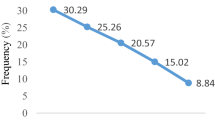Abstract
Cutaneous leishmaniasis is a vector borne infection caused by flagellated parasitic protozoans of the genus Leishmania. This is an emergent threat and endemic in areas of tropic and sub-tropics and has a wider geographical distribution. This study was aimed to find the epidemiological aspects of cutaneous leishmaniasis during the recent epidemic in district Karak in 2018–2019. The suspected patients of leishmaniasis from different areas of district Karak were examined. We came across 803 cases during six-month period from August 2018 to January 2019. A major portion (> 37%; n = 299) of these patients were in age 11–20 years. The infection rate was higher in female (55.3%; n = 803) compared to males (44.6%; n = 803). Both gender and age showed a significant effect on the occurrence of infection. It is concluded that cutaneous leishmaniasis has appeared as a major health issue in district Karak. The current study report CL outbreak in Karak district which need immediate response from the healthcare authorities. In addition, extensive awareness campaigns are needed for timely prevention of such outbreaks.


Similar content being viewed by others
References
Ali A, Rehman TU, Qureshi NA, Rahman HU (2016) New endemic focus of cutaneous leishmaniasis in Pakistan and future epidemics threats. Asian Pac J Trop Dis 6:155–159
Alvar J et al (2012) Leishmaniasis worldwide and global estimates of its incidence. PLoS ONE 7:e35671
Ayaz MM et al (2018) Cutaneous leishmaniasis in the metropolitan City of Multan, Pakistan, a neglected tropical disease. J Med Entomol 55:1040–1042
Ayub S, Khalid M, Mujtaba G, Bhutta R (2001) Profile of patients of cutaneous leishmaniasis from Multan. J-Pak Med Assoc 51:279–281
Chaudhary RG, Bilimoria FE, Katare S (2008) Diffuse cutaneous leishmaniasis: co-infection with human immunodeficiency virus (HIV). Indian J Dermatol Venereol Leprol 74:641
Clem A (2010) A current perspective on leishmaniasis. J Glob Infect Dis 2:124
Desjeux P (2001) The increase in risk factors for leishmaniasis worldwide. Trans R Soc Trop Med Hyg 95:239–243
Durrani AZ, Durrani HZ, Kamal N, Mahmood N (2011) Prevalence of cutaneous leishmaniasis in humans and dogs in Pakistan. Pak J Zool 43(2):263–271
Durrani AZ, Durrani HZ, Kamal N (2012) Prevalence of leishmania in sand fly in Pakistan. Pak J Zool 44(1):61–65
Kassi M, Kassi M, Afghan AK, Rehman R, Kasi PM (2008) Marring leishmaniasis: the stigmatization and the impact of cutaneous leishmaniasis in Pakistan and Afghanistan. PLoS Negl Trop Dis 2:e259
Kimutai R et al (2017) Safety and effectiveness of sodium stibogluconate and paromomycin combination for the treatment of visceral leishmaniasis in eastern Africa: results from a pharmacovigilance programme. Clin Drug Investig 37:259–272
Marco JD et al (2006) Multilocus enzyme electrophoresis and cytochrome b gene sequencing-based identification of Leishmania isolates from different foci of cutaneous leishmaniasis in Pakistan. Am J Trop Med Hyg 75:261–266
Mujtaba G, Khalid M (1998) Cutaneous leishmaniasis in Multan, Pakistan. Int J Dermatol 37:843–845
Mumtaz S, Munir AH, Asghar M, Naheed N (2016) Frequency and types of leishmaniasis in Khyber Pakhtunkhwa (KPK). J Med Sci 24:136–140
Organization WH (2001) Communicable disease profile Afghanistan and neighbouring countries. World Health Organization, Geneva
Organization WH (2013) Global tuberculosis report 2013. World Health Organization, Geneva
Rowland M, Munir A, Durrani N, Noyes H, Reyburn H (1999) An outbreak of cutaneous leishmaniasis in an Afghan refugee settlement in north–west Pakistan. Trans R Soc Trop Med Hyg 93:133–136
Simon Brooker NM, Adil K, Agha S, Reithinger R, Rowland M, Ali I, Kolaczinski J (2004) Leishmaniasis in refugee and local Pakistani populations. Emerg Infect Dis 10:1681
Sundar S, Benjamin B (2003) Diagnosis and treatment of Indian visceral leishmaniasis JOURNAL-ASSOCIATION OF PHYSICIANS OF INDIA 51:195–201
Vélez ID, Colmenares LM, Muñoz CA (2009) Two cases of visceral leishmaniasis in Colombia resistant to meglumine antimonial treatment. Revista do Instituto de Medicina Tropical de São Paulo 51:231–236
Acknowledgements
The authors are thankful to the department of Medicine DHQ Hospital Kohat, Khyber Pakhtunkhwa, for their kind support throughout the study.
Funding
Not available/self-funded.
Author information
Authors and Affiliations
Contributions
Supervision (MA); Data collection and validation (MN); Writing- Reviewing and Editing (MD & AK); Conceptualization, Methodology (SUD & KA); Data curation, Writing- Original draft preparation (MA & MD), Statistical analysis and initial data analysis (AK).
Corresponding author
Ethics declarations
Conflict of interest
The author(s) declare that they have no competing interests.
Ethics approval
The study was approved by ethical committee of Quaid-i-Azam University Islamabad Pakistan.
Additional information
Publisher's Note
Springer Nature remains neutral with regard to jurisdictional claims in published maps and institutional affiliations.
Rights and permissions
About this article
Cite this article
Nawaz, M., Din, M., Khan, A. et al. Epidemiological features of cutaneous leishmaniasis endemic in hilly areas of district Karak, Khyber-Pakhtunkhwa province of Pakistan. J Parasit Dis 44, 725–729 (2020). https://doi.org/10.1007/s12639-020-01250-4
Received:
Accepted:
Published:
Issue Date:
DOI: https://doi.org/10.1007/s12639-020-01250-4




